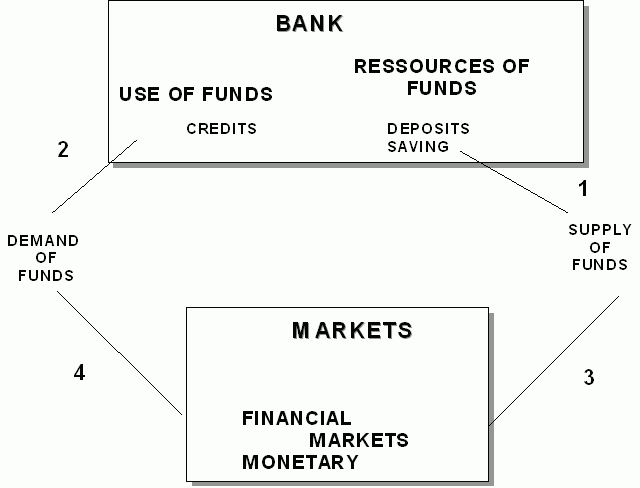The economic role of banks
Category: General Banking
Because of the diversity in the organisation of credit institutions and Banking professions, it’s quite difficult to propose a simple and complete definition of Bank.
The core business of credit institutions is to carry out banking operations.
Bank operations consist of collect public funds, provisions of credits, and payment mechanisms based customers.
This definition, if concise and clear, is legally driven and provides nothing more than an specification of the necessary operations required to be by an establishment order to be given the status of «Credit Institution».
An economic definition could be:
A bank is an intermediary between sellers and buyers of capital, in two different ways:
the inflows in and the outflows of funds appear on their balance sheets i.e. it is intermediation.
they put buyers and sellers of funds into direct contact with each other (Financial market — Monetary market) i.e. it is disintermediation.
Supply and demand of capital are generated by the activity of various economic agents. The basis of Banking activity is to try and balance the supply and demand of funds to finance the economy.
Diagram. 1.1
Economic role of a credit institution
intermediation 1 — Fund holders give their deposits and savings to the Bank.
2 — Buyers of funds ask for credits.
disintermediation 3 — Fund holders invest directly on the markets.
4 — Buyers of funds get their financing from the markets.
The role of a bank is to act as an intermediary between supply and demand of funds.
Economic agents can be classified in 7 categories
| CATEGORIES | ECONOMIC FUNCTIONS |
| Household | Consumption |
| Non financial Companies
(Industrial and Commercial firms) |
Production of goods and services to be sold |
| Credit Institutions | Financing and production of Bank services |
| Public Administrations | Production of non merchant services to the community
Redistribution of revenue and national wealth |
| Private Administration | Production of non merchant services to private groups |
| Insurance Companies | Transformation of individual risks into collective risks |
| Rest of the World (external) | Consumption: Production: Financing Transformation for non resident people |
Through their economic function, these economic agents take part in the economic circuit that will generate the supply demand of capital.
As far as the economy is concerned, there is a perfect balance between supply, revenues and expenses, but for every individual, revenues are either higher or lower than expenditure.
If the revenues are higher, there is a funding capacity.
If the revenue are lower, there is a funding need.
Structurally, households and financial institutions are on the supply side, whereas firms and the state are on the demand side.
For an individual, savings are the part of revenue that is not spent, i.e. capacity of funding.
The business of a bank is to help the supply side and the demand side balance so that the economy can be financed; This can be done either through intermediation or disintermediation.
As shown on the diagram (1.2.), the banking system is one of the three channels where supply and demand of capital can balance. So far, it still represents 60 % of the financing of the Economy.
The banking system appears on two other channels; as an adviser and an intermediary for the subscription and the issuing of shares onto the markets, and as a seller of mutual funds, securities and insurance products.
On its own, the banking system can issue or buy securities on the markets.

